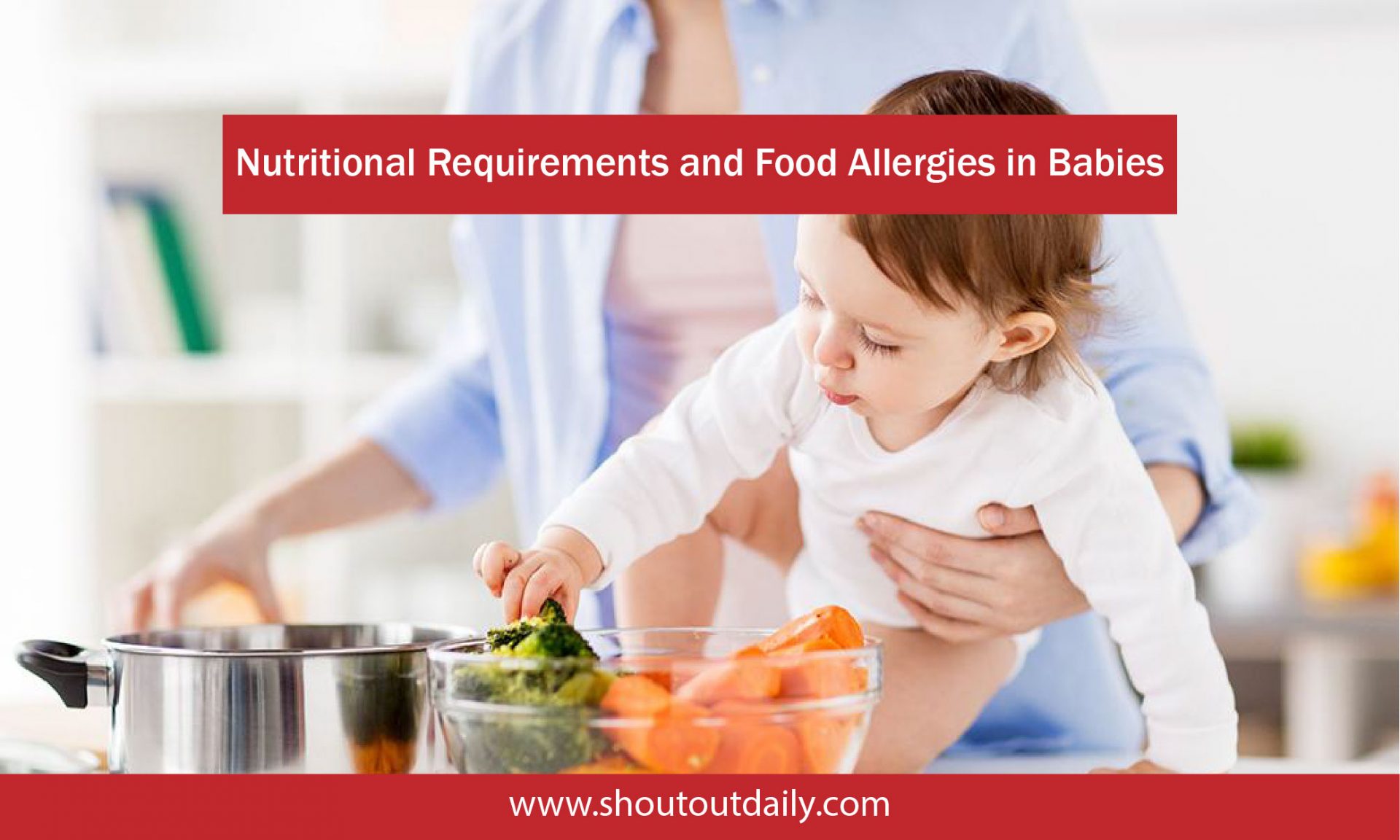A Guide to Nutritional Requirements of Babies

Introduction:
The first year of a baby’s life is the most formative period of its life. For optimal physical and mental growth, parents must understand the nutritional requirements of babies since a proper diet is crucial during this period. There’s a clear need for information on how to best provide for a baby’s nutritional needs, so it’s no wonder this issue has recently become popular. This article will cover the nutritional requirements of babies during their first year, including when and how to introduce solid foods and deal with food allergies.
Baby’s First Year: Dietary Requirements:
Babies have unique dietary requirements not met by the same foods that adults or older kids eat. Infants rely heavily on either breast milk or formula for sustenance in the first six months of their lives. Breast milk is the healthiest and most complete diet for a baby since it provides all the nutrients the infant needs. If a mother is unable or unwilling to breastfeed, the formula is a healthy option.
Babies can add solid meals to their diets after six months, in addition to breast milk or formula. The AAP suggests between four and six months of age as the time to start giving babies solid foods1. Infants must eat a balanced diet with various foods from the fruit, vegetable, grain, and protein categories.
The First Steps Towards Consuming Solids
Taking their infant on a nutritional path with solid foods is an exciting time for parents and caregivers alike. According to the AAP (American Academy of Pediatrics), you should start giving your baby solid foods between four and six months. You should talk to your baby’s pediatrician to ensure they are ready for solid foods before introducing them.
How to Introduce Solid Meals to Babies:
As baby grows the nutritional requirements of babies grows as well. Iron-fortified rice cereal is a great option for the first solid food to introduce after breast milk or formula. Iron in rice cereal makes it simple on the digestive system and aids in the fight against anemia caused by a lack of iron. Try pureed fruits and veggies to ease the transition from rice cereal to solid foods. Start with small finger foods like cooked and mashed veggies or soft fruits, then move on to pureed meats.
Every three to five days, offer one new food. If the infant develops a food allergy, doctors will have a better chance of pinpointing the offending item. Stop giving the new food to the baby and consult a pediatrician if they develop a rash, vomiting, or trouble breathing after eating it.
Timing the introduction of several solid food types:
Infants’ initial forays into solid food often contain pureed fruits and vegetables. Introduce a single new food, such as a fruit or vegetable, then wait three to five days before trying again. Bananas, applesauce, and pureed pears make excellent first fruits. Some of the best veggies to introduce to a young child include sweet potatoes, carrots, and squash.
To introduce meat, do so after introducing pureed fruits and vegetables. Start with chicken, turkey, or beef cooked thoroughly and blended until smooth. It’s best if the meat is served without any seasonings. A baby’s digestive system is not fully matured until after the age of six months. Therefore, it’s best to wait until then to introduce meat.
After your infant has mastered pureed foods, you can start introducing small, soft finger foods. Soft fruits like ripe bananas, avocados, and cooked and mashed veggies are great first-finger foods. Finger meals should be the right size to reduce choking concerns.
Here is a sample feeding chart for children up to 1 year of age:
| 6-8 Months Old |
| Breakfast: 4-6 oz formula or breast milk, 2–4 tablespoons single-grain cereal mixed with breast milk or formula, 1–2 tablespoons pureed fruit |
| Mid-morning snack: 2–4 tablespoons pureed vegetables or fruit |
| Lunch: 4-6 oz formula or breast milk, 2–4 tablespoons pureed meat, poultry, or fish, 2–4 tablespoons pureed vegetables, 1–2 tablespoons pureed fruit |
| Afternoon snack: 2–4 tablespoons pureed vegetables or fruit |
| Dinner: 4-6 oz formula or breast milk, 2–4 tablespoons pureed meat, poultry, or fish, 2–4 tablespoons pureed vegetables, 1–2 tablespoons pureed fruit |
| Bedtime snack: 2-4 oz formula or breast milk |
| 9-11 Months Old |
| Breakfast: 6-8 oz formula or breast milk, 2–4 tablespoons infant cereal or oatmeal, 1–2 tablespoons pureed fruit |
| Mid-morning snack: 2-4 tablespoons soft fruit or vegetable pieces |
| Lunch: 6-8 oz formula or breast milk, 2–4 tablespoons pureed or mashed meat, poultry, or fish, 2–4 tablespoons pureed vegetables, 1–2 tablespoons pureed fruit |
| Afternoon snack: 2-4 tablespoons soft fruit or vegetable pieces, 1-2 tablespoons infant yogurt |
| Dinner: 6-8 oz formula or breast milk, 2–4 tablespoons pureed or mashed meat, poultry, or fish, 2–4 tablespoons pureed vegetables, 1–2 tablespoons pureed fruit |
| Bedtime snack: 2-4 oz formula or breast milk, 1-2 tablespoons infant cereal or oatmeal |
| 12 Months Old |
| Breakfast: 6-8 oz formula or breast milk, 2–4 tablespoons infant cereal or oatmeal, 1–2 tablespoons soft fruit |
| Mid-morning snack: 2-4 tablespoons soft fruit or vegetable pieces, 1-2 tablespoons infant yogurt |
| Lunch: 6-8 oz formula or breast milk, 2–4 tablespoons diced or shredded meat, poultry, or fish, 2-4 tablespoons soft cooked vegetables, 1–2 tablespoons soft fruit |
| Afternoon snack: 2-4 tablespoons soft fruit or vegetable pieces, 1-2 tablespoons infant yogurt, 1-2 tablespoons cottage cheese |
| Dinner: 6-8 oz formula or breast milk, 2–4 tablespoons diced or shredded meat, poultry, or fish, 2-4 tablespoons soft cooked vegetables, 1–2 tablespoons soft fruit |
| Bedtime snack: 2-4 oz formula or breast milk, 1-2 tablespoons infant cereal or oatmeal, 1-2 tablespoons fruit puree |
It’s important to note that this is just a general guideline, and the feeding schedule should be adjusted according to the child’s individual needs and preferences. It’s essential to consult with a pediatrician or a qualified healthcare provider to ensure that the child is receiving the appropriate nutrients and is growing and developing appropriately.
Read more articles:
Supporting Young Children’s Mental Health: Tips for Parents and Caregivers
How to get rid of Trans fat in your body
Food allergies
In order to fulfill the nutritional requirements of babies parents usually make mistakes of introducing new type of food to babies at an earlier stage or quickly one after another. Parent’s worry about food allergies are rising, especially in infants. Although their immune systems are still maturing, babies are more vulnerable to allergies. Parents need to know what to look for regarding food allergies, so they can take the necessary precautions.
Exactly what is “food allergy”?
When the immune system overreacts to specific proteins in food, the result is an allergy. Immunoglobulin E is an antibody that a baby’s immune system can produce in response to a food allergen (IgE) exposure. Symptoms of this include hives, nausea, and, in the most extreme cases, vomiting and anaphylaxis.
Food Allergy Symptoms
Depending on the severity of the allergy, you may have any of the following symptoms:
- Irritation, rash, or hives
- Facial, oral, and pharyngeal swelling
- Wheeze or other respiratory distress
- Diarrhea and vomiting
- Cramping or discomfort in the abdomen
Parents should immediately take their children to the doctor when they notice these signs.
Food Allergy Prevention
- The American Academy of Pediatrics (AAP) suggests that infants be breastfed exclusively during the first six months of life to lower the risk of developing food allergies. Babies can be protected from allergies by the antibodies found in breast milk.
- Hypoallergenic baby food may be the next best thing when breastfeeding isn’t possible. Regular cow’s milk shouldn’t be given to infants younger than a year old since it can be difficult for their developing digestive systems to process.
- Solid foods should be introduced gradually and one at a time. If you suspect a food allergy, this will help you identify it. It is also wise to space out the introduction of new meals by a few days to give the body time to react in the event of an allergy.
Parents must engage with their pediatrician to create a management plan if their infant is diagnosed with a food allergy. This may include avoiding particular meals and having an epinephrine auto-injector in case of a severe allergic reaction.
A baby’s food allergy could fade as they get older. It is vital to work with a pediatrician to monitor any changes in symptoms and establish if it is safe to reintroduce the food.
Guide to Optimal Nutrition for Your Baby:
Providing babies with the proper nourishment requires more than simply the right foods. Building a community around healthy eating is also part of this. How to ensure your kid gets the best possible nutrition:
- Provide options from the four main food groups, which should be nutritious.
- Baby food should not have any added salt, sugar, or spices.
- Choose reasonable serving sizes.
- It’s best not to use food as a reward or punishment, to stick to a set feeding schedule, and to keep everyone’s attention on eating.
- Have patience and attempt to get your child to try different meals.
Conclusion:
To sum up, a baby’s first year is a crucial time for their physical and mental development, and good nutrition is necessary for that to occur. To accomplish nutritional requirements of babies, requires a varied and balanced diet from birth, beginning with breast milk or formula and progressing to solid meals as the baby develops. It is also important to develop a healthy eating environment that supports good eating habits and to be alert to the possibility of food allergies. When parents and caregivers adhere to these recommendations, infants receive the appropriate diet for healthy growth and development. When in doubt about how to feed an infant, seeing a pediatrician is important.
References:
American Academy of Pediatrics. (2021). Starting solid foods. HealthyChildren.org. https://www.healthychildren.org/English/ages-stages/baby/feeding-nutrition/Pages/Switching-To-Solid-Foods.aspx




